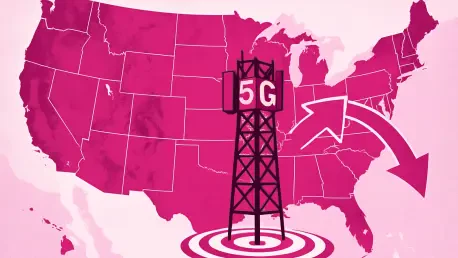In a transformative move that’s reshaping the telecommunications landscape, T-Mobile finalized its acquisition of UScellular’s wireless operations on August 1, 2025, for a staggering $4.3 billion, marking a pivotal moment in the race for 5G dominance. This strategic transaction, involving $2.6 billion in cash and $1.7 billion in assumed debt, extends far beyond a simple business deal—it’s a calculated effort to redefine connectivity across the United States. By integrating UScellular’s extensive assets, including over four million customers and 12,000 cell sites, T-Mobile is not only expanding its network footprint but also addressing long-standing connectivity gaps, particularly in rural communities. This bold step positions T-Mobile as a frontrunner in the 5G arena, promising enhanced internet access for hundreds of thousands of households and signaling a broader mission to bridge the digital divide while driving substantial business growth.
Strategic Network Growth
Expanding Rural Connectivity
The integration of UScellular’s assets into T-Mobile’s portfolio directly confronts the persistent issue of limited internet access in rural America, where many communities have long struggled with slow or nonexistent connectivity. With access to UScellular’s low-band spectrum in the 600 MHz and 700 MHz ranges, T-Mobile can achieve wide-area coverage that’s ideal for sprawling, less populated regions. Reports indicate a remarkable 50% increase in rural network capacity as a result of this deal, enabling high-speed internet to reach underserved households. This expansion isn’t merely about adding cell sites; it’s about transforming lives by providing reliable access to digital resources, from education to telehealth, in areas previously left behind by technological progress. The focus on rural regions reflects a commitment to equity in connectivity, ensuring that even remote areas benefit from the 5G revolution.
Beyond the immediate impact on connectivity, this strategic move also aligns with national priorities to close the digital divide, positioning T-Mobile as a key player in addressing a critical societal need. The addition of 12,000 cell sites across 21 new markets, predominantly in the Midwest and South, enhances T-Mobile’s ability to deliver consistent 5G services where infrastructure has historically been sparse. This isn’t just an expansion of coverage but a redefinition of what’s possible for rural economies, enabling small businesses and farmers to leverage digital tools for growth. Moreover, the deployment of T-Mobile’s in-home broadband and fixed wireless services in these areas promises to rival traditional providers, offering a lifeline to communities that have been overlooked. The ripple effects of this enhanced network capacity could reshape demographic trends as better connectivity makes rural living more viable in a digital age.
Unlocking New Markets
T-Mobile’s access to 21 new markets through the UScellular acquisition opens up untapped opportunities, particularly in regions that have been largely ignored by major carriers due to lower population density. These markets, spanning the Midwest and South, represent not just a numerical increase in coverage but a chance to connect with communities hungry for reliable internet. This expansion is a dual-purpose strategy: it drives social impact by empowering residents with digital access while simultaneously creating new revenue streams for T-Mobile. By catering to these areas, the company diversifies its customer base away from oversaturated urban centers, reducing dependency on highly competitive markets. The potential to grow in these regions underscores a forward-thinking approach to sustainable business expansion.
Equally significant is how this market penetration strengthens T-Mobile’s position as a disruptor in the telecommunications industry, challenging the status quo of connectivity distribution. The addition of over four million UScellular customers into T-Mobile’s ecosystem offers a ready-made audience for upgraded 5G services and premium plans. This isn’t merely about absorbing numbers but about cultivating loyalty through enhanced offerings tailored to regional needs. The strategic focus on these new markets also allows T-Mobile to test innovative solutions, such as localized service bundles, that could later scale to broader demographics. Furthermore, addressing connectivity gaps in these areas aligns with federal initiatives for broadband expansion, potentially unlocking incentives or partnerships that amplify the deal’s impact. This calculated expansion into new territories is a testament to T-Mobile’s vision of inclusive growth.
Financial and Operational Benefits
Synergy-Driven Savings
One of the standout aspects of T-Mobile’s acquisition of UScellular lies in the projected $1 billion in annual savings on operating and capital expenditures, a figure that speaks to the deal’s financial foresight. These synergies stem from streamlined operations, reduced redundancies, and optimized infrastructure usage across the combined entities. Such cost efficiencies enable T-Mobile to redirect resources toward enhancing customer experiences, whether through improved network quality or expanded benefits like streaming perks. Importantly, this financial discipline ensures that growth initiatives do not compromise shareholder value, maintaining a balance between investment and returns. The structure of the deal, with minimal dilution to the balance sheet, further underscores a commitment to prudent capital management.
These savings also provide a buffer to navigate the complexities of integrating a large-scale acquisition, ensuring that operational hiccups don’t derail long-term goals. With a $2.2–$2.6 billion upfront investment, T-Mobile has laid the groundwork for seamless assimilation of UScellular’s assets while keeping an eye on cost control. The anticipated efficiencies allow for reinvestment into cutting-edge projects, such as satellite connectivity initiatives, which could redefine service delivery in remote areas. Additionally, preserving a $14 billion shareholder return authorization for the current year highlights a strategy that prioritizes investor confidence alongside expansion. This synergy-driven approach not only strengthens T-Mobile’s financial health but also sets a precedent for how acquisitions can fuel innovation without straining resources, offering a model for industry peers to consider.
Revenue Growth Opportunities
The integration of UScellular’s customer base into T-Mobile’s ecosystem is poised to drive significant revenue growth, with projections estimating a 12–15% increase in average revenue per user over the next 12 months. Transitioning these customers to T-Mobile’s unlimited plans offers an immediate uplift in billing potential, as premium services and bundled offerings become accessible to a broader audience. This revenue boost is not just a short-term gain but a stepping stone to building long-term customer loyalty through superior network performance and value-added features. The focus on upselling in these newly acquired customer segments demonstrates a keen understanding of market dynamics and consumer behavior in the telecommunications space.
Moreover, this revenue opportunity extends beyond individual subscribers to include potential growth in fixed wireless and in-home broadband services, particularly in rural markets where competition is less intense. By leveraging UScellular’s existing relationships and infrastructure, T-Mobile can quickly roll out tailored solutions that meet local demand, further enhancing income streams. The financial outlook is bolstered by a broader strategy to diversify revenue sources, reducing reliance on urban-centric markets and balancing the portfolio with growth from less-saturated areas. This approach not only mitigates risks associated with market saturation but also positions T-Mobile to capitalize on emerging trends in digital consumption. The revenue growth tied to this acquisition reflects a meticulous plan to maximize returns while expanding access, aligning business objectives with societal benefits.
Competitive Positioning in 5G
Enhancing Network Performance
A critical advantage of the UScellular acquisition is the addition of mid-band spectrum assets, such as AWS and 2.5 GHz, which significantly enhance T-Mobile’s 5G network capacity for high-tier plans and advanced services. These spectrum holdings allow for faster data speeds and improved reliability, catering to the growing demand for seamless connectivity in both urban and rural settings. Independent benchmarks from Ookla and Opensignal already rank T-Mobile’s 5G network as the fastest in the U.S., with median download speeds reaching 299.36 Mbps in the first half of the year. This performance edge is vital in a market where speed and consistency define customer satisfaction, giving T-Mobile a distinct competitive advantage over rivals. The bolstered network infrastructure ensures that subscribers experience cutting-edge technology, reinforcing brand loyalty.
This enhanced network performance also positions T-Mobile to meet the escalating needs of data-intensive applications, from streaming high-definition content to supporting smart home ecosystems. The integration of UScellular’s spectrum resources means that T-Mobile can handle increased traffic without compromising quality, a crucial factor as 5G adoption continues to surge. This capability is particularly impactful for business customers who rely on robust connectivity for operations, expanding T-Mobile’s appeal beyond consumer markets. Additionally, the improved capacity supports the rollout of next-generation services, ensuring that T-Mobile remains at the forefront of technological advancements. By prioritizing network excellence through strategic spectrum acquisition, T-Mobile sets a high bar for competitors, shaping industry standards for 5G delivery and user experience.
Innovative Partnerships
T-Mobile’s forward-thinking approach to connectivity is exemplified by strategic collaborations, such as the T-Satellite initiative with SpaceX’s Starlink, aimed at providing service in the most remote locations where traditional infrastructure falls short. This partnership leverages satellite technology to extend 5G coverage to areas previously deemed unreachable, setting T-Mobile apart in an industry often constrained by geographical limitations. Such innovation not only addresses connectivity challenges but also enhances the company’s reputation as a pioneer in telecommunications solutions. The ability to offer seamless internet access, regardless of location, creates a unique value proposition that differentiates T-Mobile from other major carriers.
These partnerships also signal a broader vision of redefining how connectivity is delivered, pushing beyond conventional cell tower networks to embrace cutting-edge alternatives. The collaboration for satellite connectivity complements T-Mobile’s ground-based expansion, creating a hybrid model that ensures comprehensive coverage. This approach is particularly relevant as demand for universal access grows, driven by remote work, digital education, and telemedicine needs. By investing in such innovative solutions, T-Mobile not only captures new customer segments but also mitigates competitive pressures from peers who may lag in adopting similar technologies. The emphasis on partnerships reflects a proactive stance on future-proofing the network, ensuring that T-Mobile remains a leader in the evolving 5G landscape while addressing real-world connectivity barriers.









